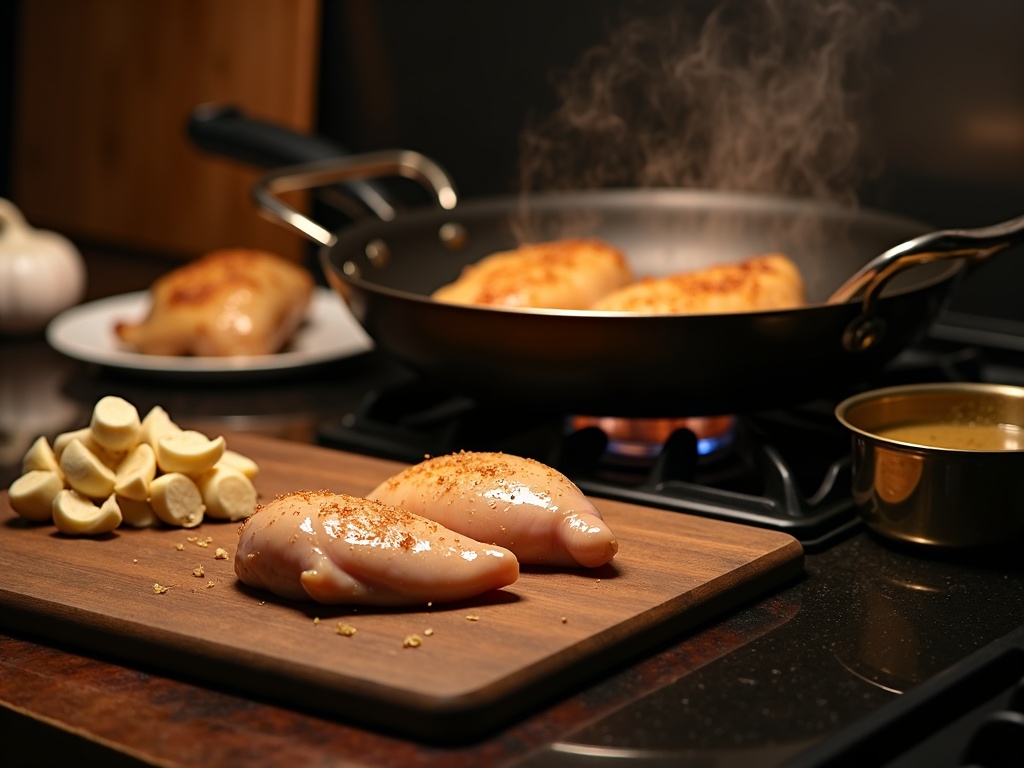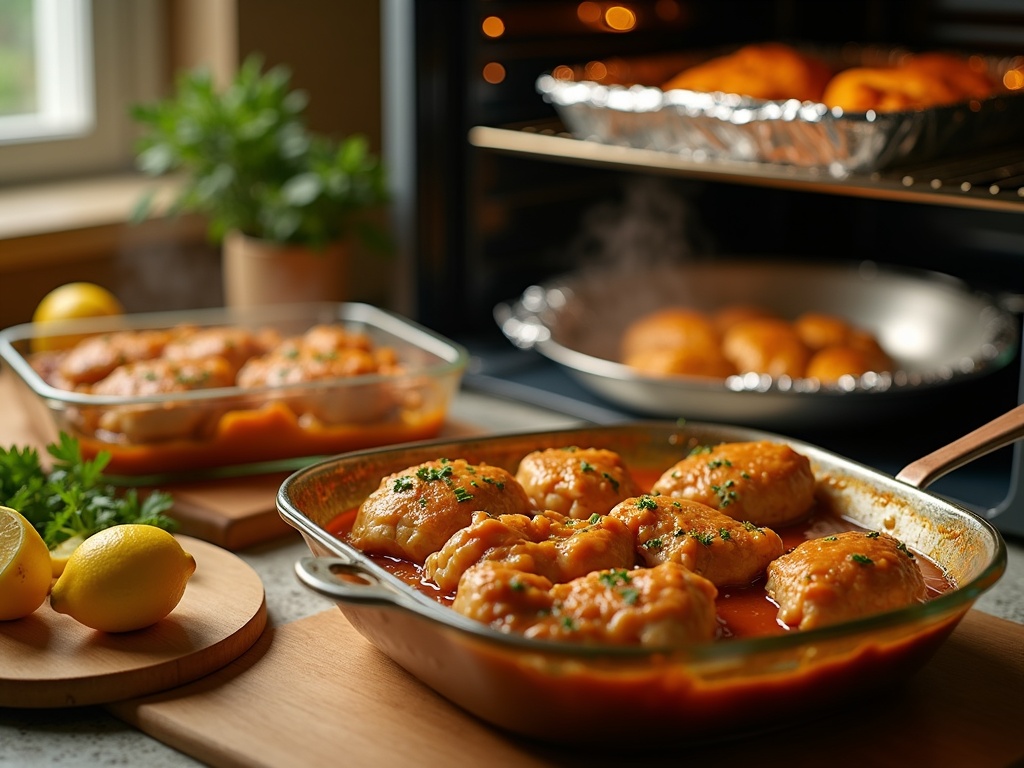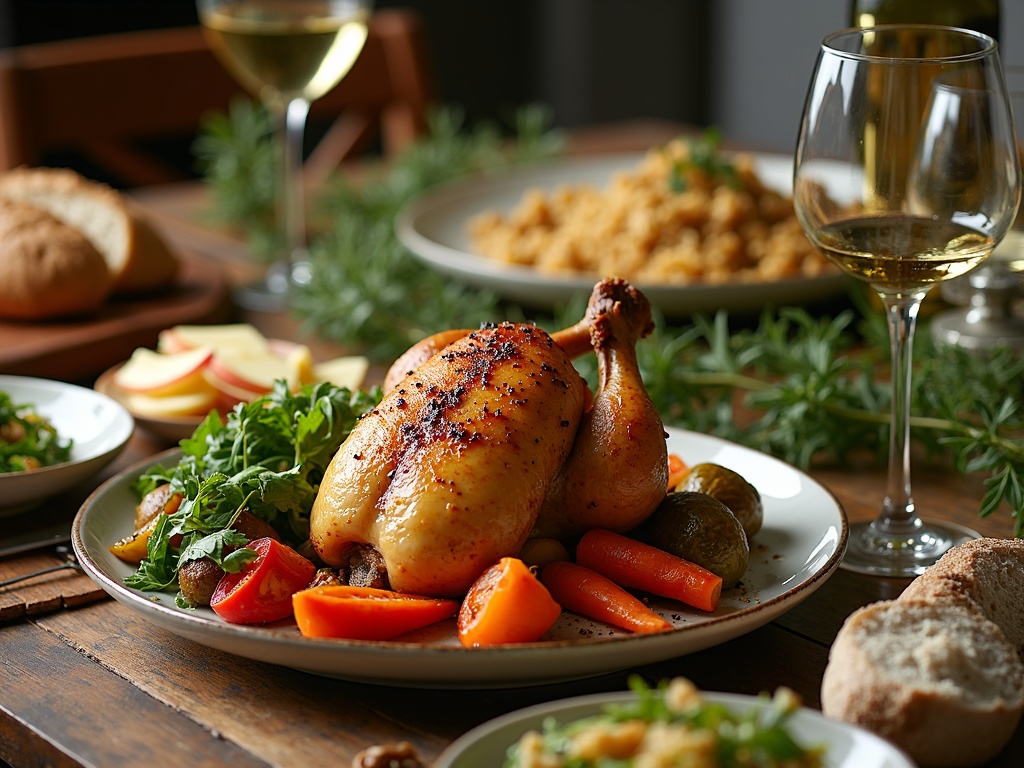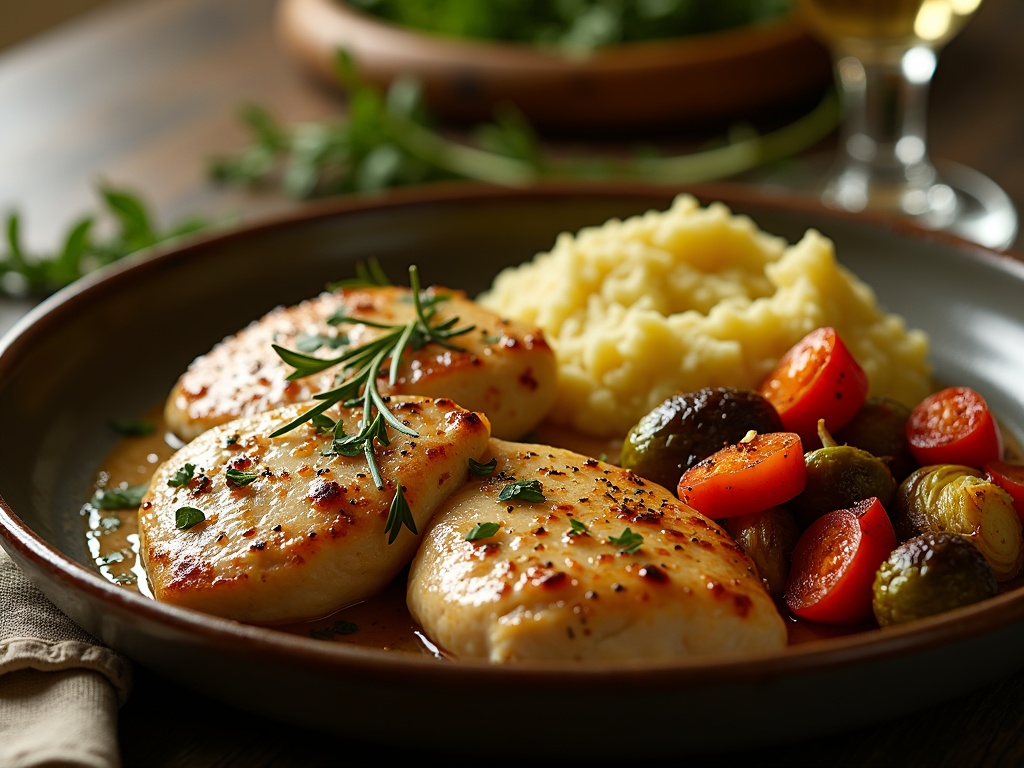Garlic chicken combines tender poultry with aromatic garlic, turning simple protein into a flavor-packed meal in just 30 minutes. This dish stands out for balancing convenience with impressive taste, making it perfect for quick weeknight dinners or special occasions while delivering juicy, flavorful results every time.
Find In This Article
Key Takeaways
- Using both fresh and powdered garlic creates depth of flavor that can’t be achieved with just one form.
- Proper preparation techniques, including patting chicken dry before cooking, ensure better browning and juicier results.
- Heat management is crucial — cook chicken at medium-high heat for searing but add garlic later to prevent burning and bitterness.
- Allow chicken to rest for 5-10 minutes after cooking to redistribute juices and improve overall texture.
- Leftover garlic chicken can be stored for up to three days and often tastes even better the next day as flavors continue to develop.
What Makes This Recipe Special
Garlic chicken has rightfully earned its place as a staple in my weekly meal rotation. The beautiful marriage of pungent garlic with perfectly cooked chicken creates a dish that satisfies even the pickiest eaters at my dinner table. This recipe stands out for several reasons that make it worth adding to your repertoire.
A Time-Saving Kitchen Hero
When life gets busy, I need recipes that deliver maximum flavor without keeping me chained to the stove. This garlic chicken recipe fits the bill perfectly—it’s ready in just 30 minutes from start to finish. After a long workday, I can have a homemade meal on the table faster than delivery would arrive.
The quick preparation time doesn’t mean sacrificing quality either. Unlike some rushed weeknight meals, this dish tastes like something I spent hours perfecting. The secret lies in the cooking technique that allows the chicken to cook rapidly while maintaining all its moisture and tenderness.
For those nights when I’m looking for other quick chicken options, I sometimes switch to boiling chicken breasts for a different preparation method that’s equally efficient. But this garlic-infused version adds so much more flavor in nearly the same time.
Flavor Profile That Impresses
The true star of this dish is the perfect blend of garlic and herbs that creates layers of flavor in every bite. I’ve found that using both fresh and powdered garlic creates a depth that can’t be achieved with just one form—the fresh provides a punchy brightness while the powder offers a more mellow, rounded garlic note.
The herb blend complements rather than competes with the garlic. A careful mix of thyme, rosemary, and a touch of parsley highlights the chicken’s natural flavors while adding their own aromatic qualities. I sometimes add a sprinkle of red pepper flakes for heat, which works beautifully with the garlic backbone.
This flavor combination is so addictive that I’ve started using similar profiles in other dishes like my favorite chicken pie recipe for an elevated comfort food experience.
The following elements make this garlic chicken truly exceptional:
- The marinade penetrates deeply into the meat, ensuring flavor in every layer
- A quick sear locks in juices before finishing the cooking process
- The garlic-herb sauce creates both a flavor coating and a delicious drizzle for serving
- The balanced seasoning means it pairs well with almost any side dish
I’ve never served this dish without receiving compliments, even from guests who claim they’re tired of chicken recipes. It transforms the humble chicken breast or thigh into something worthy of a special occasion while remaining simple enough for everyday cooking.
For those who enjoy bold flavors, this recipe offers a gateway to other garlic-forward dishes like butter chicken, though with a different flavor profile.
The consistency of results is perhaps what makes this recipe most special. Whether I’m cooking for myself on a casual Tuesday or hosting a dinner party, the chicken turns out tender and juicy every single time. The technique prevents the dreaded dry chicken that plagues so many home cooks, making it foolproof even for beginners in the kitchen.
For packed lunches the next day, these flavorful chicken pieces make an outstanding chicken sandwich for school lunch or work meal prep, proving its versatility beyond dinner.

Essential Ingredients For Perfect Garlic Chicken
Creating delicious garlic chicken starts with gathering the right ingredients. The combination of tender chicken, fragrant garlic, and complementary seasonings creates a dish that’s both satisfying and full of flavor. Let me break down the essential components you’ll need for perfect results.
Key Components for Flavor and Texture
Chicken serves as the foundation of this dish, and your choice matters. I prefer using boneless, skinless chicken breasts for a leaner option, but chicken thighs offer more moisture and flavor. Thighs work particularly well in recipes like butter chicken with garlic where juiciness is key.
Fresh garlic cloves are non-negotiable. Pre-minced garlic from jars simply won’t deliver the same punch of flavor as freshly crushed or minced cloves. For the best garlic chicken, I use 4–6 large cloves, finely minced or pressed.
The fat components—olive oil and butter—create the perfect cooking medium. Olive oil has a higher smoke point for initial searing, while butter adds richness and helps create a golden crust on the chicken. This combination is also the base for many fried chicken recipes that incorporate garlic.
Italian seasoning provides a balanced herb profile with oregano, basil, thyme, and rosemary. This blend complements the garlic perfectly without overwhelming it. You’ll need salt and freshly ground black pepper to enhance all the flavors.
Fresh parsley isn’t just a garnish—it adds brightness and color contrast to the finished dish. Its mild flavor helps balance the intensity of the garlic. I often add it both during cooking and as a final touch.
Chicken broth creates the base for a luxurious sauce. The broth helps deglaze the pan, picking up all the flavorful bits from the bottom while providing moisture to keep your chicken tender. This technique is especially important when preparing boiled chicken breast with garlic infusion.
These ingredients form the core of a classic garlic chicken recipe, but you can certainly experiment with additions. Some delicious variations include:
- Adding lemon juice for brightness
- Incorporating Parmesan cheese for richness
- Mixing in red pepper flakes for heat
For a complete meal, consider incorporating these ingredients into a chicken pie recipe or chicken biryani for a fusion twist.
The quality of your ingredients significantly impacts the final result. Whenever possible, opt for organic, free-range chicken and fresh, local produce for the most flavorful outcome.
Step-By-Step Cooking Instructions
Starting with properly prepared chicken makes all the difference in a delicious garlic chicken dish. I always pat my chicken breasts dry with paper towels before cooking. This step ensures better browning and prevents the meat from steaming instead of searing.
Once dry, I season both sides generously with salt and pepper. For extra flavor, I sometimes add a touch of paprika or Italian seasoning at this stage, but the classic salt and pepper combination works perfectly for highlighting the garlic flavor later.
Next, I heat olive oil in a large skillet over medium-high heat. When the oil begins to shimmer, I carefully place the chicken in the pan. To achieve that gorgeous golden-brown crust, I let the chicken cook undisturbed for about 4–5 minutes per side. This patience pays off with perfectly seared meat that locks in juices and flavor.
After the chicken is nicely browned, I remove it from the skillet and set it aside on a plate. It doesn’t need to be fully cooked at this point — we’ll finish it later in the sauce.
Creating The Garlic Sauce
Using the same pan keeps all those wonderful flavors in your dish. I add minced garlic (about 4–6 cloves depending on your preference) to the hot skillet, stirring constantly for about 30 seconds until fragrant. Be careful not to burn the garlic as it can become bitter.
Next, I add 2–3 tablespoons of butter along with fresh herbs like thyme or rosemary. The butter creates a rich base for the sauce while helping to mellow the intense garlic flavor.
Now it’s time to return the chicken to the pan, adding about 1/2 cup of chicken broth to create a flavorful sauce. I reduce the heat to medium-low, cover the pan, and let everything simmer for about 5–10 minutes until the chicken is completely cooked through (internal temperature should reach 165°F).
For a complete meal, I like serving this flavorful garlic chicken with steamed vegetables or a simple salad. If you prefer something heartier, try it over pasta or with roasted potatoes to soak up that amazing sauce.
This technique works equally well for making tasty chicken sandwiches — just slice the cooked chicken and pile it on bread with some of that garlic sauce drizzled on top.
For busy weeknights, I sometimes partially boil chicken breasts before finishing them in the garlic sauce, which cuts down on cooking time while still delivering great flavor.

Common Mistakes To Watch For
I’ve made my fair share of garlic chicken mishaps before perfecting this dish. Learning from these errors has dramatically improved my results, and I’m sharing these insights so you can avoid the same pitfalls in your kitchen adventures.
Cooking Technique Errors
Overcrowding the pan is perhaps the most common mistake I see home cooks make. When too many chicken pieces are crammed together, they steam rather than sear. This prevents that gorgeous golden crust from forming and results in pale, soggy chicken. Instead, I cook in batches if needed, giving each piece enough space to develop that perfect caramelization.
Heat management can make or break your garlic chicken. Too high, and the garlic burns quickly, turning bitter and unpleasant. Too low, and the chicken never develops that appealing color and texture. I find medium to medium-high heat works best for most stovetop garlic chicken recipes. This allows the chicken to cook through while giving the garlic enough time to infuse flavor without burning.
Before cooking, I always take a moment to properly prepare my chicken. Not patting chicken dry before cooking is a mistake that prevents proper browning. Surface moisture creates steam, interfering with the Maillard reaction that creates those flavorful browned edges. I simply use paper towels to thoroughly dry the chicken pieces before seasoning and cooking them. This small step makes a significant difference in the final crispy chicken texture and flavor development.
Garlic Timing Issues
The timing of when you add garlic can completely transform your dish. Adding garlic too early is perhaps the most disappointing mistake because it ruins the star flavor component. Garlic burns quickly – often in less than a minute – and burned garlic imparts a harsh, acrid taste that can’t be fixed.
I typically add minced garlic only in the final 30-60 seconds of sautéing, which gives it just enough time to become fragrant without scorching. For longer cooking times, I add whole garlic cloves that can slowly infuse flavor without burning, or I add minced garlic later in the cooking process.
Another approach I love for chicken recipes requiring longer cooking is to create a garlic infusion in oil first, strain out the solids, and use this flavored oil for cooking. This prevents burning while still delivering that beautiful garlic flavor.
For dishes like butter chicken, garlic is often added to a sauce base rather than directly with the meat, which helps preserve its aromatic qualities without risking that bitter burned taste.
Some recipes call for adding garlic at different stages – perhaps some at the beginning (whole cloves) and some at the end (minced) – to create layers of flavor. This technique works beautifully for chicken biryani and other complex dishes where you want both mellow, cooked garlic notes and bright, fresh garlic punch.
The type of garlic preparation also affects timing. Here’s how I adjust my cooking based on garlic preparation:
- Whole cloves: Can cook longer, adding early in the process
- Sliced garlic: Medium cooking time, add midway
- Minced or pressed garlic: Very quick to burn, add near the end
- Garlic paste: Tends to burn quickly, add later or mix into sauces
Recognizing that different chicken cooking methods require different garlic approaches has improved my garlic chicken immensely. For instance, when making chicken sandwiches, I might add garlic to a marinade instead of the cooking process to prevent burning while still getting that flavor infusion.
By avoiding these common mistakes, your garlic chicken will consistently turn out flavorful, aromatic, and perfectly cooked – never bitter or bland. The difference is noticeable, turning a good meal into a memorable one that your family or guests will rave about.
Pro Tips For Best Results
Elevating Your Garlic Chicken Experience
I’ve found that a few simple adjustments can transform your garlic chicken from good to exceptional. Starting with room temperature chicken makes a significant difference. Taking your chicken out of the refrigerator 20-30 minutes before cooking allows for more even cooking and better absorption of flavors. Cold chicken straight from the fridge often cooks unevenly, leaving you with overcooked exteriors and potentially undercooked centers.
Fresh garlic delivers flavor that simply can’t be matched by pre-minced alternatives. While pre-minced garlic in jars offers convenience, it loses much of its potent flavor and aromatic qualities during processing. I prefer crushing or finely chopping fresh garlic cloves just before adding them to the pan – this releases their essential oils and creates that unmistakable aroma that makes garlic-infused chicken dishes so irresistible.
Patience pays off when it comes to resting your chicken after cooking. Let me share why this step shouldn’t be skipped:
- Allows juices to redistribute throughout the meat
- Prevents moisture loss when cutting
- Helps the chicken maintain its temperature
- Improves overall texture and tenderness
A 5-10 minute rest under loosely tented foil makes a remarkable difference. I’ve found this particularly important when preparing perfectly cooked chicken breasts that tend to dry out easily.
Don’t waste that delicious pan sauce! After removing your chicken from the cooking pan, you’ll notice caramelized bits and flavorful juices remaining. This concentrated garlic-infused goodness makes an exceptional finishing sauce. I like to add a splash of chicken broth or white wine to the hot pan, scrape up those flavorful bits, and reduce slightly before drizzling over the sliced chicken. This simple step adds moisture and intensifies the garlic flavor profile.
These straightforward techniques don’t require special equipment or ingredients but make all the difference between an ordinary chicken dinner and a memorable garlic chicken experience that your family will request again and again.

Storage And Reheating
Proper storage and reheating techniques can make all the difference in preserving the delicious flavors of garlic chicken. After spending time preparing a flavorful garlic chicken dish, the last thing I want is for leftovers to go to waste or lose their appeal. Let me share some practical tips to help you enjoy your garlic chicken even days after cooking it.
Keeping Your Garlic Chicken Fresh
When it comes to storage, garlic chicken requires careful handling to maintain its quality and prevent bacterial growth. After cooking, I always let the chicken cool to room temperature before refrigerating — but never leave it out for more than two hours. This cooling period prevents condensation that can make your chicken soggy when stored.
For optimal freshness, store your garlic chicken in an airtight container. This simple step does several important things:
- Prevents cross-contamination with other foods in your refrigerator
- Keeps the chicken from absorbing other odors
- Maintains moisture levels so the chicken doesn’t dry out
- Helps preserve the intensity of the garlic flavor
When stored properly in the refrigerator, garlic chicken stays good for up to three days. I find that the garlic flavor sometimes intensifies slightly during storage, which can actually enhance the dish when reheated properly.
If you’ve prepared a large batch of chicken with garlic and want to extend its shelf life, freezing is an option. Just portion it into individual servings in freezer-safe containers before freezing, which will make reheating easier later.
How to Reheat Garlic Chicken
Reheating requires gentle handling to avoid drying out the chicken. I prefer reheating on low heat, whether using a stovetop, oven, or microwave. The key is patience — quick high-heat reheating will leave you with tough, rubbery chicken.
When reheating garlic chicken on the stovetop, adding a splash of chicken broth works wonders. This extra moisture revitalizes the sauce and keeps the chicken tender. Just:
- Place the chicken in a skillet with 2–3 tablespoons of broth per serving
- Cover the skillet
- Heat on low until it reaches 165°F internally
For oven reheating, I place the chicken in an oven-safe dish, add a splash of broth, cover with foil, and warm at 325°F for about 10–15 minutes until thoroughly heated. This gentle method preserves both texture and flavor.
Even microwave reheating can work well if done carefully. Place your garlic chicken in a microwave-safe container, add a tablespoon of broth, cover loosely, and heat at 50% power in short intervals, stirring between each until hot throughout.
I’ve found that garlic chicken often tastes even better the next day after the flavors have had time to meld together. It makes an excellent option for meal prep or planning ahead for quick lunches during a busy week.
One last tip: when serving previously refrigerated garlic chicken, a light sprinkle of fresh chopped herbs (like parsley or cilantro) or a squeeze of lemon juice can brighten up the flavors and make it taste freshly made. This simple addition makes reheated garlic chicken feel special rather than just leftover food.
By following these storage and reheating recommendations, your chicken recipes with garlic will remain delicious and safe to eat for days after you initially cook them.

Perfect Pairings
Garlic chicken shines when paired with the right side dishes that complement its savory, aromatic flavors. I’ve discovered several combinations that elevate this classic dish from excellent to extraordinary, creating a balanced meal that will impress family and friends.
Complementary Side Dishes
Roasted vegetables make an ideal partner for flavorful garlic chicken, as the roasting process enhances their natural sweetness. The caramelization of vegetables like carrots, brussels sprouts, and bell peppers creates a delightful contrast to the savory chicken. Simply toss with olive oil, salt, and pepper before roasting at 400°F for about 25 minutes.
Mashed potatoes offer the perfect creamy counterpoint to garlic chicken’s bold flavors. The smooth texture and mild taste create a canvas for soaking up the delicious garlic sauce. For an elevated twist, try adding roasted garlic to your mashed potatoes for an echo of the main dish’s flavors.
Rice pilaf brings a nutty, aromatic element that pairs wonderfully with chicken dishes. The fluffy grains soak up the garlic-infused sauce beautifully. I often add some toasted almonds and a hint of lemon zest to brighten the dish and create texture contrast.
A fresh green salad provides welcome brightness and acidity to balance the rich flavors of garlic chicken. Consider these salad ingredients to maximize the pairing:
- Bitter greens like arugula or watercress that cut through the richness
- Acid components such as lemon vinaigrette or balsamic glaze
- Crunchy elements like toasted walnuts or crisp apple slices
- Fresh herbs including parsley or dill for aromatic freshness
For those looking for a heartier meal, savory chicken recipes like garlic chicken also pair wonderfully with crusty bread for sopping up sauce or pasta tossed in olive oil and fresh herbs.
Wine enthusiasts will appreciate that garlic chicken matches beautifully with medium-bodied whites like Chardonnay or light reds such as Pinot Noir. The wine’s acidity helps cleanse the palate between bites of this flavorful dish.
These pairings aren’t just tasty—they create a balanced plate with complementary flavors, textures, and nutritional elements. When serving delicious chicken recipes, these side dishes will help you create a memorable dining experience that satisfies on every level.


